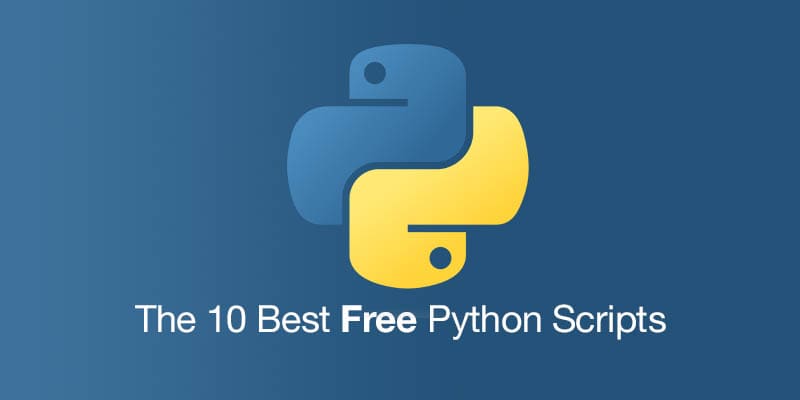The 10 Best Free Python Scripts

Python is a versatile and powerful language, ideal for a wide range of applications from automation and web scraping to data analysis and machine learning. Below are ten of the best free Python scripts, each with detailed descriptions, examples, and download links to help you streamline your tasks and enhance your projects.
1. Automate the Boring Stuff with Python
Author: Al Sweigart Description: This collection of scripts, based on the popular book “Automate the Boring Stuff with Python,” is designed to help you automate everyday tasks. The scripts cover a variety of topics including web scraping, file manipulation, working with Excel, and interacting with APIs. These scripts are perfect for beginners looking to get practical experience with Python.
- Example: Automate the download of files from a list of URLs. The script reads a list of URLs from a text file and downloads each file to a specified directory.
- Download Link: Automate the Boring Stuff Scripts
2. Pandas Data Analysis
Author: Wes McKinney Description: Pandas is a powerful library for data manipulation and analysis. This script provides examples of how to use Pandas for various data analysis tasks such as reading data from CSV files, cleaning data, and performing complex data transformations. It’s essential for anyone working with large datasets.
- Example: Read a CSV file, clean missing values, and perform a group-by operation to summarize the data.
- Download Link: Pandas Data Analysis Examples
3. Web Scraping with BeautifulSoup
Author: Leonard Richardson Description: BeautifulSoup is a library for parsing HTML and XML documents. This script demonstrates how to extract data from web pages, making it ideal for tasks such as scraping product information from e-commerce sites or gathering data from web forms.
- Example: Scrape product prices from an e-commerce site. The script navigates through the HTML structure of the page to extract and print product names and prices.
- Download Link: BeautifulSoup Examples
4. Data Visualization with Matplotlib
Author: John D. Hunter Description: Matplotlib is a comprehensive library for creating static, animated, and interactive visualizations in Python. This script includes examples of creating various types of plots, such as line graphs, bar charts, and scatter plots. It’s an excellent tool for anyone looking to visualize their data.
- Example: Generate a bar chart from a set of data. The script takes a list of categories and their corresponding values and creates a bar chart.
- Download Link: Matplotlib Examples
5. Automating Excel with openpyxl
Author: Eric Gazoni Description: openpyxl allows you to read and write Excel files in Python. This script demonstrates how to automate tasks like updating spreadsheets, generating reports, and formatting cells. It’s particularly useful for business analysts and anyone who works extensively with Excel.
- Example: Create and format an Excel report. The script opens an Excel file, writes data into specific cells, and applies formatting to the cells.
- Download Link: openpyxl Examples
6. Task Automation with Selenium
Author: SeleniumHQ Description: Selenium is used for automating web browsers. This script shows how to automate web interactions, such as form submissions, navigation, and data extraction. It’s particularly useful for testing web applications and scraping dynamic web content.
- Example: Automate login to a website and scrape data. The script navigates to a login page, enters credentials, logs in, and then scrapes data from a user-specific page.
- Download Link: Selenium Examples
7. Machine Learning with Scikit-learn
Author: Various Description: Scikit-learn is a machine learning library that provides simple and efficient tools for data mining and data analysis. This script includes examples of classification, regression, clustering, and dimensionality reduction. It’s a great resource for data scientists and machine learning enthusiasts.
- Example: Build and train a machine learning model. The script demonstrates how to load a dataset, split it into training and testing sets, train a model, and evaluate its performance.
- Download Link: Scikit-learn Examples
8. Natural Language Processing with NLTK
Author: Steven Bird, Ewan Klein, and Edward Loper Description: NLTK (Natural Language Toolkit) is a library for working with human language data. This script demonstrates various text processing tasks such as tokenization, part-of-speech tagging, and sentiment analysis. It’s ideal for anyone working with text data or developing language-based applications.
- Example: Analyze the sentiment of customer reviews. The script processes a list of reviews, tokenizes the text, and applies sentiment analysis to determine the overall sentiment.
- Download Link: NLTK Examples
9. API Interaction with Requests
Author: Kenneth Reitz Description: Requests is a simple and elegant HTTP library for Python. This script shows how to interact with APIs by sending HTTP requests and handling responses. It’s essential for developers working with web services and APIs.
- Example: Fetch data from a public API and process the JSON response. The script sends a GET request to an API endpoint, parses the JSON response, and prints the relevant data.
- Download Link: Requests Examples
10. Command-Line Tools with argparse
Author: Python Software Foundation Description: argparse is a module for parsing command-line arguments. This script illustrates how to build a command-line interface (CLI) for your Python scripts, making them more user-friendly and versatile.
- Example: Create a script that accepts file paths as arguments and processes the files. The script uses argparse to handle command-line arguments and then performs operations on the provided files.
- Download Link: argparse Examples
Conclusion
These Python scripts cover a wide range of applications, from automation and web scraping to data analysis and machine learning. Each script is well-supported with comprehensive documentation and a strong community, making them ideal tools for both beginners and experienced programmers. By incorporating these scripts into your workflow, you can save time, improve efficiency, and gain deeper insights from your data.